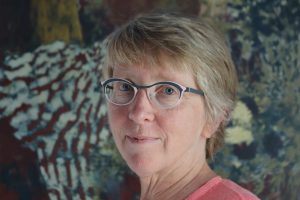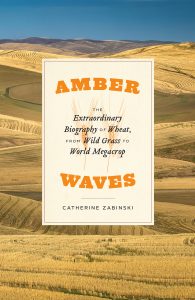5 Questions for Catherine Zabinski, author of “Amber Waves: The Extraordinary Biography of Wheat, from Wild Grass to World Megacrop”
It’s harvest season! What better time to dip into agricultural history? Wheat was one of the first domesticated food crops, and for roughly 8,000 years it has been a dietary staple in Europe, West Asia, and North Africa. Today, wheat is grown on more land area than any other commercial crop, and it continues to be the most important food grain for humans. A plant this prolific surely deserves its own biography. In Amber Waves, Catherine Zabinski invites us to follow the evolutionary journey of wheat while exploring its symbiotic relationship with humans. We are introduced to the habits and history of this member of the grass family, how it lives, how it thrives, and how it arrived at its current form. We learn how our ancestors discovered and exploited the grain, which went on to be foundational to the development of civilization—from the wild grasses first cultivated in the Fertile Crescent to the ancient empires that sought to control its production. And in modern times, we discover wheat’s role in the Green Revolution and contemporary efforts to produce a perennial form. From the origins of agriculture to gluten sensitivities and genetic engineering, Amber Waves sheds new light on how we grow the food that sustains so much human life. We sent Zabinski a few questions recently to learn more about her motivations for writing the book.
How did you wind up in your field, and what do you love about it?
I am a plant and soil ecologist, and my research is on ways that soil biota and plant roots interact to increase plants’ ability to grow on disturbed sites. Initially, I focused my work on metal-contaminated sites, sites that have high concentrations of invasive species, and high elevation sites impacted by recreation. I was particularly interested in how disturbance affected ecological processes in soil, and how ecological restoration could address that. I started thinking about agricultural systems about ten years ago, after a sabbatical year working in France. Experiencing the importance for French people of place and how that relates to the quality of food and wine helped me to see that the questions that I ask about plant and soil interactions in natural areas and disturbed areas were equally relevant to our agricultural systems.
In Amber Waves, you explicitly set out to write a biography of wheat. Why that approach?
Scientists use a technical vocabulary for our research. It’s an important aspect of advancing our knowledge, because it allows us to communicate really precisely. But that same language can serve as a barrier to talking about our work to people who aren’t practicing scientists. When I started thinking about expanding my audience from the students in my classes at the university to a broader public, I thought a lot about how I could write about the science underlying agriculture in a way that would be accessible and interesting. My story needed a character, and because plants are often underappreciated, I thought framing the question as a biography of one of our food plants could be a way for me and for my readers to consider our relationship to food plants from a different perspective.
While you were working on this project, what did you learn that surprised you the most?
Perhaps what surprised me the most was how much I learned. It wasn’t incredibly insightful on my part, but I hadn’t anticipated how much history would be involved when writing about a plant from the origins of agriculture through present day. My initial book outline pretty much jumped from early agriculture to Darwin, but the story didn’t allow me to do that. Fortunately, there are historians who have done a really nice job researching food and agriculture, enabling me to pick up the threads of the story.
But there was also a big learning curve on the other end of the story, about genome sequencing and the acronym-laden vocabulary of plant genomics. I started attending genomics conferences, at first, sitting in the back and googling all the acronyms so I could understand the research being presented. Even as a scientist, the technical vocabulary can be a barrier.
Where will your research and writing take you next?
There is really no end in sight to the questions that exist about how plants and soil microbes
interact to affect plant communities and soil processes like nutrient cycling and decomposition. My lab research will continue in both natural and agricultural systems. Wes Jackson made the salient point that ecologists can’t afford to ignore agricultural systems, as our need for food and for lands to grow food will only increase in coming decades.
As far as my writing, there are so many interesting stories about food, how we grow and produce that food, how place—including climate, soils, and local practices—affect our food supply. I’m deeply engaged in learning more about that and as Eula Biss describes it, translating those stories for people.
What’s the best book you’ve read lately?
I’ve been enjoying Bill Buford’s Dirt: Adventures in Lyon as a Chef in Training, Father, and Sleuth Looking for the Secret of French Cooking. Because much of my writing is technical science writing, I read beautifully written non-science books as a way to experience language and stories. Valeria Luiselli’s The Story of My Teethis an amazing homage to storytelling. Carolyn Forché’s recent poetry collection, In the Lateness of the World, has been my companion lately. And I just started reading A. S. Barwich’s Smellosophy: What the Nose Tells the Mind, which I anticipate will be on my favorite books list.

Catherine Zabinski is professor of plant and soil ecology in the Department of Land Resources and Environmental Sciences at Montana State University in Bozeman. She received a fellowship from the Arthur P. Sloan Foundation to work on this book.
Amber Waves is available now! Find it on our website or at your favorite bookseller.
